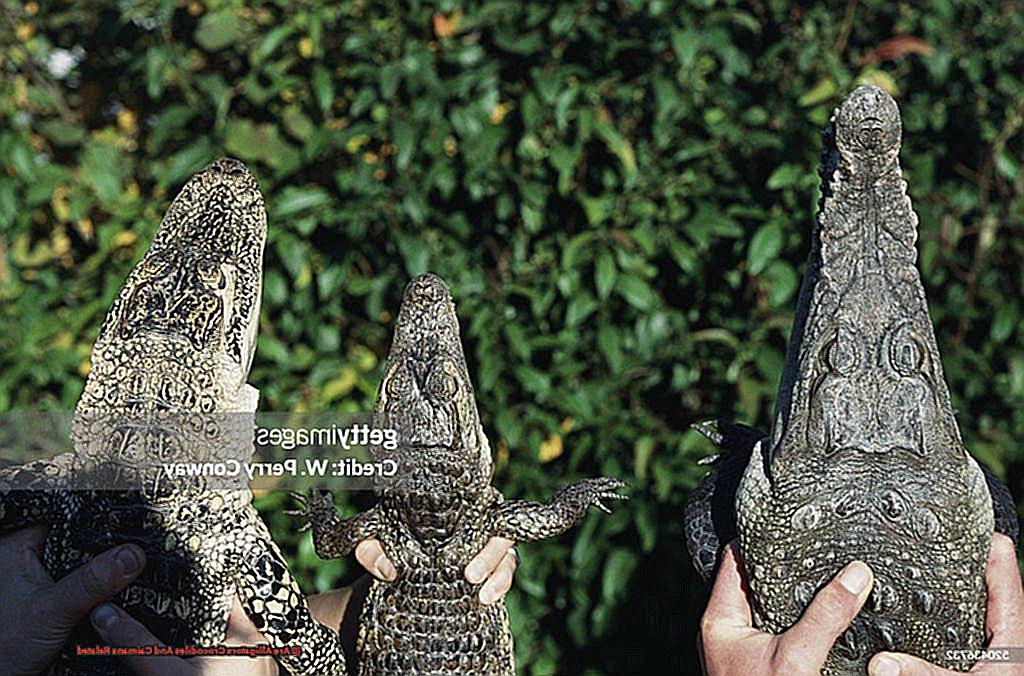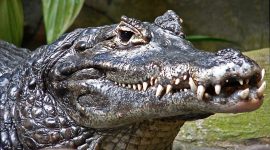
We’re about to embark on a journey into the mysterious world of alligators, crocodiles, and caimans. These three creatures may seem like they belong in the same family, but don’t be fooled by their scaly exteriors.
Each one has its own distinct features and quirks that make them stand out in the animal kingdom. From their razor-sharp teeth to their impressive hunting skills, there’s no denying these reptilian relatives are top predators.
So, buckle up and get ready to discover the untold secrets of these ancient creatures.
Are Alligators Crocodiles And Caimans Related?
Contents
- 1 Are Alligators Crocodiles And Caimans Related?
- 2 Exploring the Reptilian Order: Understanding the Crocodilia Classification
- 3 Habitat and Distribution: Where You Can Find Alligators, Crocodiles, and Caimans
- 4 Snout Shape Differences: Examining the Physical Characteristics of Each Species
- 5 Common Ancestry: DNA Evidence That Links Alligators, Crocodiles, and Caimans
- 6 Shared Traits: Similarities in Scaly Skin, Powerful Jaws, and Aquatic Abilities
- 7 Surprising Connections: The Relation Between Crocodilians and Birds
- 8 Conclusion
Alligators, crocodiles, and caimans are three fascinating creatures that have captured the imagination of humans for centuries. With their powerful jaws, scaly skin, and impressive size, it’s no wonder that these animals have become the subject of many myths and legends.
But as a specialist in the topic of crocodilians, I am here to set the record straight and share some insights into the genetic relationship between these three creatures.
Firstly, let’s establish some basic facts. Alligators, crocodiles, and caimans all belong to the order Crocodilia, which is a group of large, semiaquatic reptiles. They share common physical characteristics such as a long, muscular body, short legs, and a powerful tail. However, they do have some key differences that set them apart from each other.
One of the most notable differences is their geographic distribution. Alligators are mainly found in freshwater habitats in the southeastern United States and China, while crocodiles can be found in both freshwater and saltwater habitats across the world. Caimans, on the other hand, are only found in Central and South America and have a more limited distribution compared to alligators and crocodiles.
But what about their genetic relationship? Are these three animals able to interbreed with each other?
While all three are closely related, they are unable to interbreed due to differences in their genetic makeup. Alligators and caimans are more closely related to each other than they are to crocodiles. Both alligators and caimans belong to the family Alligatoridae, while crocodiles belong to the family Crocodylidae. However, all three animals share a common ancestor and have evolved differently over time to adapt to their respective environments.
Attempts at interbreeding have been made in captivity, but the resulting offspring were sterile. This is a common occurrence among closely related species, as it prevents the dilution of genetic traits and maintains the integrity of each species.
Exploring the Reptilian Order: Understanding the Crocodilia Classification
As a reptile expert, I am often asked about the differences between alligators, crocodiles, and caimans. While these creatures may seem similar at first glance, there are significant distinctions that set them apart. In this blog post, I will dive into the world of crocodilians and discuss the importance of understanding their classification.
The Crocodilia order is a subcategory of the reptilian class and includes three main families: Alligatoridae (alligators and caimans), Crocodylidae (crocodiles), and Gavialidae (gharials). These families are further divided into different species, each with its unique characteristics and traits.
Contrary to popular belief, alligators, crocodiles, and caimans are not just different names for the same animal. They are distinct species with their own evolutionary history and genetic makeup. As an expert, it is crucial to understand these differences to accurately classify these magnificent creatures.
One of the most noticeable differences between these species lies in their physical features. Alligators have a broad U-shaped snout, while crocodiles have a longer, V-shaped snout. Caimans fall somewhere in between with a more rounded snout. This difference in snout shape is correlated with their diet and habitat preferences. Alligators primarily feed on fish and small prey, while crocodiles have a more varied diet that includes larger animals such as deer and buffalo.
Another distinguishing feature is their teeth placement. Alligators have a fourth tooth on their lower jaw that fits into a socket on their upper jaw, making it invisible when their mouths are closed. Crocodiles, on the other hand, have interlocking teeth visible even when their mouths are shut. Caimans also have interlocking teeth but lack the fourth tooth found in alligators.
Habitat is another factor that sets these species apart. Alligators and caimans prefer freshwater environments such as swamps, lakes, and rivers. Crocodiles, on the other hand, are more versatile and can be found in both freshwater and saltwater habitats.
Habitat and Distribution: Where You Can Find Alligators, Crocodiles, and Caimans
If you’re a fan of reptiles, you’re probably familiar with the alligator, crocodile, and caiman – three of the most well-known and feared creatures in the animal kingdom. But have you ever wondered where these creatures can be found in the wild? As an expert on all things crocodilian, let me take you on a journey to explore the distribution and habitat preferences of these fascinating creatures.
Alligators, crocodiles, and caimans may seem similar, but they actually have distinct differences when it comes to their range and adaptations to different environments. Let’s dive in and discover more about these incredible creatures.
Where to Find Alligators
Alligators are primarily found in the southeastern United States, particularly in Florida and Louisiana. These stealthy predators can also be found in other southern states such as Georgia, Alabama, and Mississippi. They prefer warm, tropical climates and are often found near water sources such as rivers, lakes, and swamps.
What About Crocodiles?
Crocodiles have a much wider distribution compared to alligators. They can be found in various countries in Asia, Africa, Australia, and the Americas. Unlike alligators, crocodiles can survive in both freshwater and saltwater habitats. In fact, they are known to inhabit brackish water environments where freshwater meets saltwater.
The Caiman’s Habitat
Last but not least, we have the caiman – a smaller relative of the alligator and crocodile. Caimans are native to Central and South America, with the largest populations in Brazil, Argentina, and Paraguay. Similar to alligators and crocodiles, they also prefer warm, tropical climates with access to water sources.
Territorial Creatures

All three species share a common preference for warm climates and water sources, but they do have their own territories. Alligators are mainly found in the southeastern United States, while crocodiles inhabit a wider range of countries. Caimans, on the other hand, are limited to Central and South America. These creatures are also territorial and tend to stay within a specific range of their habitat.
Snout Shape Differences: Examining the Physical Characteristics of Each Species
When you think of alligators, crocodiles, and caimans, their sharp teeth and powerful bodies may come to mind. But did you know that their snout shape is also a significant factor in their survival and hunting abilities? As an expert on these creatures, I have studied and observed their physical characteristics, and I am here to share with you the fascinating differences in their snout shape and how it affects their lives.
Alligators, crocodiles, and caimans all belong to the same order of reptiles, but each species has unique features that make them distinct from one another. One of these features is their snout shape. Alligators have a broad and rounded snout, while crocodiles have a more pointed and V-shaped snout. Caimans fall somewhere in between, with a slightly narrower snout than alligators but not as pointed as crocodiles.
But why do these creatures have different snout shapes? The answer lies in their diets. Alligators are primarily freshwater predators, feeding on fish, turtles, and small mammals. Their broad and rounded snouts allow them to have a better grip on their prey, making it easier for them to catch and consume their food.
On the other hand, crocodiles have a more diverse diet and are known to eat larger prey such as birds, mammals, and other reptiles. Their pointed snouts help them to be more efficient hunters, allowing them to grab their prey quickly and hold onto it while they submerge underwater to drown it.
Caimans, being smaller in size compared to alligators and crocodiles, have a more varied diet depending on their habitat. They can be found in both freshwater and saltwater environments, which influences their food choices. Their intermediate snout shape allows them to hunt a wide range of prey, from fish and insects to larger animals like birds and rodents.
But snout shape not only affects their hunting abilities, but it also plays a role in regulating their body temperature. Alligators, with their broader snouts, are able to absorb more heat from the sun, helping them maintain a stable body temperature. Crocodiles, with their narrower snouts, are better at dissipating heat, making them more suited for warm climates. Caimans, with their intermediate snout shape, have a balance of both abilities and can adapt to various temperatures.
Common Ancestry: DNA Evidence That Links Alligators, Crocodiles, and Caimans
When we think of ancient reptiles, the first creatures that come to mind are often alligators, crocodiles, and caimans. These fierce predators have been around for millions of years, adapting and evolving to survive in their changing environments. But what many people may not know is that these three species share a common ancestry that can be traced back over 200 million years ago during the Mesozoic Era.
So how do we know that alligators, crocodiles, and caimans are related? The answer lies in DNA evidence. Yes, you read that right – scientists have been able to use DNA to uncover the shared heritage of these powerful reptiles.
But before we dive into the details of this fascinating discovery, let’s take a look at some key characteristics and behaviors that alligators, crocodiles, and caimans have in common.
Similarities in Physical Features and Behaviors
Despite their physical differences, alligators, crocodiles, and caimans share many similarities in their body structure and behaviors. For starters, they all belong to the same order – Crocodilia – which is a group of large, semi-aquatic reptiles. This means that they spend most of their time in the water but can also navigate on land.
All three species have elongated bodies with powerful jaws and sharp teeth designed for hunting and eating prey. They also have similar reproductive habits, including building nests for their eggs and caring for their young after hatching. In addition, alligators, crocodiles, and caimans communicate with each other through vocalizations and body language.
DNA Evidence for a Common Ancestry
One of the main pieces of evidence for the common ancestry of these three species is their similar body structure and skull shape. This suggests a close evolutionary relationship and a shared ancestor.
But the most compelling evidence comes from DNA studies. Researchers have found that alligators, crocodiles, and caimans share a significant amount of genetic material, despite their physical differences. In fact, they have a higher percentage of genetic similarity with each other than with other reptiles. This strongly supports the theory of a common ancestry among these three species.
As a reptile enthusiast, I have always been fascinated by the similarities and differences between alligators, crocodiles, and caimans. These three creatures may seem similar at first glance, but upon closer examination, one can uncover a world of shared traits that truly highlight their close evolutionary relationship.
Scaly Skin: A Protective and Adaptive Feature
One of the most striking shared traits between these three creatures is their scaly skin. Alligators, crocodiles, and caimans all have a tough and protective exterior thanks to the presence of thick, bony plates called osteoderms embedded in their skin. These osteoderms not only provide protection against predators but also serve as insulation and aid in regulating body temperature. This allows these creatures to thrive in a variety of environments, from sweltering swamps to cool rivers.
Powerful Jaws: A Formidable Weapon
Another shared trait that sets alligators, crocodiles, and caimans apart from other creatures is their powerful jaws. With bite forces ranging from 2,000 to 3,000 pounds per square inch, these ancient reptiles have one of the strongest bites in the animal kingdom. This is due to their large and muscular jaw muscles, which are used for hunting and defending against predators. So next time you see one of these fierce predators basking in the sun with their mouths wide open, remember that it’s not just for show – it’s a display of their incredible strength.
Aquatic Adaptability: A Key Feature
Alligators, crocodiles, and caimans are truly masters of the water. Their webbed feet and powerful tails make them excellent swimmers, allowing them to move swiftly through water and catch prey with ease. They are also able to hold their breath for extended periods of time, making them skilled hunters in both the water and on land. This adaptability to aquatic life is a key feature that further solidifies their close evolutionary relationship.
Surprising Connections: The Relation Between Crocodilians and Birds
It may come as a shock, but did you know that crocodilians and birds are closely related? These two groups of animals, which seem worlds apart, actually share a common evolutionary ancestor. As an expert on the topic, I am excited to delve into this surprising connection and share with you some fascinating facts about these species.
Archosaurs: A Common Ancestor
Both crocodilians and birds belong to a group of animals called archosaurs, which includes reptiles and birds. This group is believed to have evolved from a common ancestor around 250 million years ago. This means that despite their vastly different appearances and behaviors, crocodilians and birds share a similar genetic makeup.
Similar Physical Characteristics
Upon closer examination, it becomes clear that crocodilians and birds share many physical characteristics. Both have scales covering their bodies, a four-chambered heart, and a unique type of eggshell. These similarities are not just coincidental; they are evidence of their shared ancestry.
Birds Evolved from Dinosaurs?
It may be surprising to learn that birds actually evolved from a group of small, two-legged dinosaurs known as theropods. These creatures were closely related to crocodilians and were the ancestors of modern-day birds. This means that crocodilians are more closely related to birds than they are to other reptiles like snakes and lizards.
Link to Bird Ancestors
Recent studies have also uncovered some interesting links between crocodilians and their bird ancestors. One study found that certain species of crocodiles and alligators possess feathers on their bodies, indicating a possible link to their bird ancestors. This discovery further solidifies the close connection between these two species.
Studying Together for Better Understanding
The surprising connection between crocodilians and birds has led scientists to study both groups together in order to better understand their evolution and behavior. One study even found that crocodilians exhibit complex parental care behaviors similar to those seen in some bird species. This highlights the importance of studying different species together in order to gain a deeper understanding of their place in the natural world.
Conclusion
In conclusion, our journey through the world of alligators, crocodiles, and caimans has revealed a plethora of intriguing information about these ancient creatures. From their physical characteristics to their habitats and genetic relationships, we have delved deep into the lives of these top predators.
Despite their similar appearances, it is important to note that alligators, crocodiles, and caimans are distinct species with unique features and adaptations. While they may share a common ancestor and have evolved separately over time, they still possess shared traits that link them together.
Furthermore, our exploration has shed light on the unexpected connection between crocodilians and birds. This highlights the significance of studying different species in tandem for a more comprehensive understanding of their evolution and behavior.
As you encounter one of these majestic creatures in the wild or at a zoo, remember the untold secrets we have uncovered about their world.


